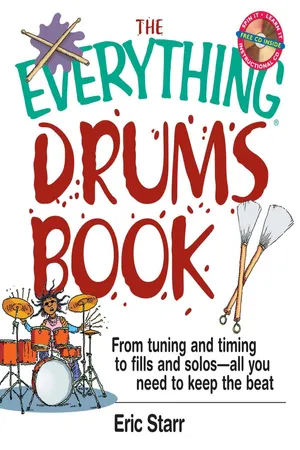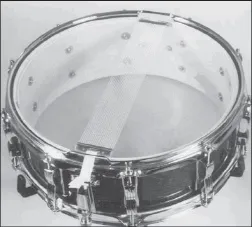![]()
Chapter 1
Getting Started
Before you begin playing, you will need to prepare mentally for the job ahead. Also, since you will need to make a few purchases, you’ll need to know the difference between quality instruments and poorly made ones. Finally, you will need to know how to set up and position your drums and/or practice pads. In brief, this chapter will give you the answers you need to start off correctly.
Mental Preparation
Before you pick up the sticks, it’s important to cleanse your mind of any myths or other wrongheaded notions you may have about music. First of all, don’t worry about becoming the best drummer in the world. Instead, focus on your budding relationship with music, and begin defining some basic objectives.
Start by asking yourself these questions:
• Would I like to become a professional or am I only interested in music as a hobby?
• Is there a particular style of music I would like to learn about? If so, what?
• Am I only interested in playing on a drum set or are there other percussion instruments I’d like to try?
• How committed am I to regular practice?
What other questions might you have? It’s important that you begin developing a keen sense for music and drumming, and asking yourself questions will help you to become more focused. Keep in mind that you don’t need to have every question answered immediately. All you need to do is start ruminating on them. Also, remember that your answers to many of these questions will change as the weeks, months, and years go by and your skills improve.
Are you saying that spontaneity is bad?
There is nothing wrong with jamming or spontaneity. That’s not the point. Certainly, there is an element to music that is born of surprise: from experimentation, mistakes, bursts of inspiration, and from just throwing caution to the wind and whacking those drums.
Each week, make a list of your musical goals and see how it evolves over time. When you play drums, or any instrument for that matter, you must first realize that everything you do should be deliberate and well conceived. Mindlessly flailing away on your drum set does you no good. In other words, if you don’t think about what you’re doing, your playing will reflect it.
Strong performances are mostly the result of training and mental discipline. You know you’re a solid player when you have the ability to play what you want to play, rather than what just happens to come out. So for now, just concentrate on being deliberate and thoughtful in your practice. In the end, your jamming (or improvising) will be better for it. Why? You’ll be in control, not your bad habits.
Keeping an Open Mind
The world is brimming with musical philosophies and there are many approaches to learning. One of the goals of The Everything® Drums Book is to help you get in touch with yourself and the way or ways you learn best. There is no one right way to do things. Similarly, there is no one wrong way either. Each person enters the musical arena with a different physiological and psychological makeup. Because of this, it is important to tailor your learning to best fit your needs.
Recognize that you are an individual with unique strengths and weaknesses. However, don’t use this as an excuse to close yourself off from the world around you, to rationalize mediocrity, or make excuses to avoid learning the essentials of music making. Instead, use your individuality as a springboard for honest and thoughtful musical exploration.
If you reject ideas and concepts that seem foreign or even in conflict with your own, you will never improve. Instead, you will spiral down a dark path toward stubbornness and ignorance. Learning an instrument means that you must be an open receptacle for information and ideas. So, stay flexible, study the trails that have already been blazed, and heed the advice of those who have more experience than you.
Staying on Task
If you can’t figure something out, or if you can’t seem to play something the way you know it should be played, be patient and keep practicing. For many, frustration stands in the way of progress. However, this needn’t be the case. Many students begin a task and conveniently set it aside because they tell themselves “I can’t do it.” Further, many students give up before they even begin. Don’t let this be you. The truth is, you can accomplish anything you set your mind to if you plan appropriately, maintain a positive attitude, work diligently, and remain patient. Patience, and its close relative perseverance, is tantamount to success. So stay on task. Don’t just skim through the exercises in this book, or try them once only to say “This is too hard” or “I can’t do this.” There will be snags along the way, but the frustration now will be the joy later.
Musical roadblocks will stand in your way, but don’t avoid them. Recognize these obstacles as challenges and overcome them. This will bring you a feeling of fulfillment and accomplishment. Almost nothing worth doing is easy.
Buying the Right Drums and Cymbals
Some professionals contend that any drum can sound good, while others are extremely picky about what they will play on. For your purposes, just about any drum or cymbal that is in good condition will do. Use your ears when deciding. Does the drum or cymbal have a tone that is pleasing to you? If not, try something else. If it’s a drum in question, ask the clerk at the store if it has been tuned recently. Often, even great drums sound lousy in stores because they are factory-direct or have not been tuned in months, or ever.
Who to Buy From
The most respected drum manufacturers today are Ludwig, Tama, Pearl, Yamaha, Drum Workshop (DW), Gretsch, Slingerland, Premier, Sonor, Noble & Cooley, and Remo. Ayotte and Peavey are companies on the rise, and there are vintage drums, such as Rogers and Leedy, still being sold today. Finally, Grover Pro Percussion makes high-end snare drums.
You can’t go wrong with any of these companies. However, it’s important to stay away from cheaply made plywood drums or overpriced, low-quality student model sets. If you’re a smart consumer, you can find used semiprofessional (or even pro) drum sets made by the companies previously listed for almost the same price as many new student model sets!
Cymbals
The same applies for cymbals. Cymbals are tapered, circular brass plates that contain a small cup or bell that swells at the cymbal’s center. Two cymbals stacked on top of each other and played both with the hands and with a foot pedal are called hi-hats. The big three cymbal manufacturers are Zildjian, Sabian, and Paiste. Zildjian is recognized as the oldest company in the world dating back to the 1600s; they also far outsell any other cymbal manufacturer.
However, this doesn’t mean that Zildjian is the only quality cymbal company or even the best. Other companies such as Istanbul (Agop and Mehmet), Bosphorus, and Meinl make high-quality cymbals as well. Istanbul and Bosphorus offer genuine hand-hammered cymbals that are made exclusively in Turkey. Meinl offers a fine hand-hammered Turkish line of cymbals, too, although most of their models are manufactured in Germany. In general, Meinl can also be hard to find on American shores and some of their lines are not sold in the United States at all.
Meinl and Bosphorus are probably the least-recognized cymbal companies, but their reputations are growing and their product lines are as good as the big three companies, if not superior. In particular, Bosphorus’s Master Series is absolutely exquisite, as is Meinl’s Byzance Series. Meinl also makes fine hand percussion instruments.
The biggest problem with all cymbals these days is their cost. Again, as with drums, used cymbals may be your best bet. In fact, some professionals will only play on used cymbals because they have a warmer tone and don’t need to be “broken in.”
The Snare Drum
As a beginner, the snare drum is the main instrument you will be focusing on, and is the central instrument within the drum set. There are essentially two types of snare drums on the market: wooden-shelled drums and chrome-shelled drums. In rare cases, you may come across plastic- or composite-shelled drums, too. A common starter snare drum is a chrome 5½" × 14" eight-lug drum.
The snare drum contains:
• A shell or circular body
• A top “batter” head and a bottom ultra-thin clear head
• Chrome hoops (rims) that fasten the heads to the shell
• Tension rods that screw into lug casings (these are used to tighten the rim onto the shell)
• Snare wires
• A throw-off apparatus
Whatever drum you buy, make certain that the snare (thin metal strings on the bottom of the drum) are intact and that the throw-off lever on the side of the drum works properly. The throw-off is a chrome apparatus found on the side or shell of the snare drum. It contains a lever that snaps the snare wires up against the bottom drumhead or releases them so that they hang about 1/8" below the head. See FIGURES 1-1 and 1-2.
FIGURE 1-1 Snare drum, top view
When the throw-off or strainer is in the up position, you will hear the buzz of the snare wires. When the throw-off is in the sideways position, the drum will sound similar to a high-pitched tom-tom. Tom-toms are similar to snare drums in that they have two heads fastened to a shell. They do not contain snare wires though. They also differ from the snare drum in their function. You will learn about the function of tom-toms in Chapters 14 and 15.
When checking the snare strainer, make sure that you can turn the snares on and off without too much effort. Also, make sure that the snares tighten and release quietly. If you do not get this on-off effect at all, it may simply mean that the snare wires are too loose.
FIGURE 1-2 Snare drum, bottom view
All quality snare drums have an adjustment knob that is part of the throw-off apparatus. If the snare is not working properly, try tightening this knob. You should feel the tension increase depending on the direction you turn it. If you turn the knob and it has no effect on the sound of the drum, chances are the apparatus is faulty. Don’t buy this drum.
Finally—and this goes for any drum—check to see if the drum has any cracks in the shell and make sure t...





